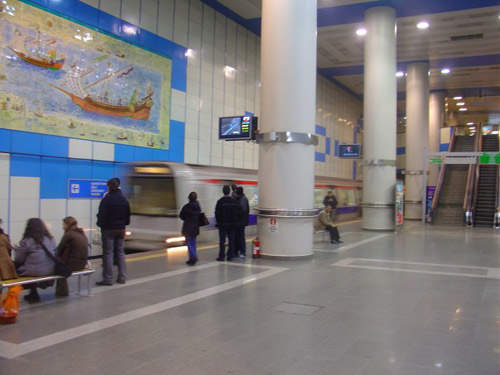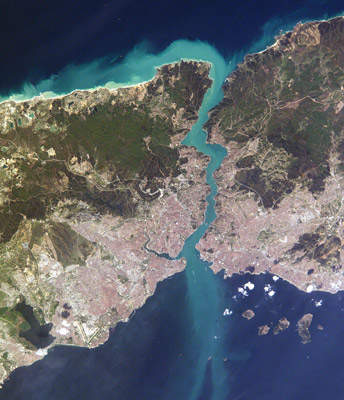The Istanbul Metro, a rapid transit underground railway network, is owned by Istanbul Metropolitan Municipality and located in Istanbul, Turkey. A heavy metro line, the Istanbul Metro is also known as the M2. It is being operated by Istanbul Ulasım AS. The metro is entirely underground and has a curved shape.
The metro has two lines: one on the European side and another on the Asian side. The construction of the first line, on the European side, began in 1992. The first stage of the 8.5km line, which connects six stations, opened to the public on 16 September 2000. The European side route is a north to south line that connects Ataturk Oto Sanayi Station with Sishane Station.
A 21.66km-long M2 line on the Asian side, which connects 16 stations from Kadikoy to Kartal, was inaugurated in August 2012. The line was built at a cost of $1.6bn. It is expected to serve 700,000 passengers per day.
The metro’s platforms are 180m long. The track gauge of the European side line is 1,435mm.
Routes
The line on the European side travels through Haciosman, Seyrantepe-Stadyum, Darussafaka, Ataturk Oto Sanayi, İTU-Ayazaga, Sanayi Mahallesi, 4 Levent, Levent, Gayrettepe, Sisli-Mecidiyekoy, Osmanbey and Taksim. A line upgrade project will extend the route to Sishane, Unkapanı and Sehzadebası stations.
The Asian side line links Kadikoy, İbrahimaga, Acibadem, Unalan, Goztepe, Yenisahra, Kozyatagı, Bostanci, Kucukyalı, Altaycesme, Maltepe, Gulsuyu, Cevizli, Hastane, Soganlık and Kartal.
Upgrade
The upgrade project includes extensions to the northern and southern ends of the metro’s European side. The total length of the European side’s extended metro line is 23km. The extension will cost $593m.
The northern extension of the European side from 4 Levent to Ataturk Oto Sanayi station was officially inaugurated on 30 January 2009. The southern extension line, which connects Taksim with Yenikapı via the Golden Horn, is being built. It is expected to be completed by 2015. The line will be connected to the Marmaray cross-Bosphorus suburban service and M1 light metro line. The Taksim-Yenikapı’s southern extension will be 5.2km long and have four stations, at Taksim, Sishane, Unkapanı and Yenikapi.
The opening of the southern extension was delayed because of archaeological discoveries made during the construction process. The section of the southern extension between Taksim and Sishane was tested by running railcars along the line in November 2007. Trains on the European side were operated in three segments: Taksim to Sishane on the southern extension line, and Taksim to Ataturk Oto Sanayi and Taksim to 4 Levant on the northern extension line.
Contracts
A €139m contract was awarded to rolling stock manufacturer CAF in September 2009 by Istanbul Metropolitan Municipality to provide 30 eight-car metro trainsets for the Kadikoy-Kartal metro line. The eight-car metro trainsets are 90m long, able to accommodate 1,300 passengers and use 1-5kV DC overhead electrification.
In October 2009 Istanbul Metropolitan Municipality awarded a €36m contract to Thales to provide train control and signalling systems to the Kadikoy-Kartal line. Integrated systems including SelTrac CBTC were installed, supplied and maintained by Thales.
Siemens AG acted as the signalling sub-contractor for the second and third phases of the metro project.
Alstom won a contract to supply and install electromechanical works on a 1.8km extension of the metro connecting Taksim and Sishane. The contract also included a signalling system featuring automatic train control (ATC), automatic train supervision (ATS), power supply, auxiliary power, ventilation, trackwork and station equipment such as lifts and escalators.
Alstom also supplied modular induction traction motors, switchgear panels and transformers for the project.
Rolling stock
The air-conditioned railcars built by Alstom for the European side entered into service in September 2000. Liquid crystal display (LCD) screens were also installed. Rolling stock for the Asian side was also built by Alstom and is operated on the Taksim-4 Levent segment.
The new 92 four-cars built by Eurotem for the European side entered into service in 2009 and operate on the Taksim-Sishane and 4 Levent-Ataturk Oto Sanayi sections. The railcars cost about $127m and are equipped with LCD screens and dynamic digital maps displaying the location and direction of the train.










